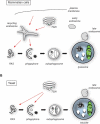Atg9 proteins, not so different after all
- PMID: 29966469
- PMCID: PMC6103728
- DOI: 10.1080/15548627.2018.1477382
Atg9 proteins, not so different after all
Abstract
Macroautophagy (hereafter autophagy) is a catabolic pathway present in all eukaryotic cells. The yeast Saccharomyces cerevisiae has been pivotal in the identification and characterization of the key autophagy-related (Atg) proteins, which play a central role in the generation of autophagosomes. The components of the core Atg/ATG machinery and their functions are highly conserved among species, although mammalian cells also have isoforms and auxiliary factors. Atg9/ATG9 is the only transmembrane protein that is part of the core Atg/ATG machinery, but it appears to have divergent localizations and molecular roles in yeast and mammals. A recent experimental analysis of the yeast endo-lysosomal system by the laboratory of Benjamin Glick, however, suggests a more simple organization of this membrane system. Although this study has not examined yeast Atg9, its findings place this protein in the same compartments as its mammalian counterpart. Here, we will discuss the implications of this conceptual change on the trafficking of yeast Atg9 and its function in autophagy.
Keywords: ATG9A; Atg9; endosomes; recycling endosomes; trafficking; trans-Golgi network.
Figures

Similar articles
-
Atg9 reservoirs, a new organelle of the yeast endomembrane system?Autophagy. 2010 Nov;6(8):1221-3. doi: 10.4161/auto.6.8.13792. Epub 2010 Nov 16. Autophagy. 2010. PMID: 20962573
-
Atg9A trafficking through the recycling endosomes is required for autophagosome formation.J Cell Sci. 2016 Oct 15;129(20):3781-3791. doi: 10.1242/jcs.196196. Epub 2016 Sep 1. J Cell Sci. 2016. PMID: 27587839
-
Atg9 trafficking in the yeast Saccharomyces cerevisiae.Autophagy. 2007 Mar-Apr;3(2):145-8. doi: 10.4161/auto.3608. Epub 2007 Mar 21. Autophagy. 2007. PMID: 17204846 Review.
-
Atg9 trafficking in Mammalian cells.Autophagy. 2007 Jan-Feb;3(1):54-6. doi: 10.4161/auto.3419. Epub 2007 Jan 20. Autophagy. 2007. PMID: 17102588 Review.
-
Atg27 is a second transmembrane cycling protein.Autophagy. 2007 May-Jun;3(3):254-6. doi: 10.4161/auto.3823. Epub 2007 May 11. Autophagy. 2007. PMID: 17297289
Cited by
-
--Atg9 interactions via its transmembrane domains are required for phagophore expansion during autophagy.Autophagy. 2023 May;19(5):1459-1478. doi: 10.1080/15548627.2022.2136340. Epub 2022 Nov 10. Autophagy. 2023. PMID: 36354155 Free PMC article.
-
Protein complexes and neighborhoods driving autophagy.Autophagy. 2021 Oct;17(10):2689-2705. doi: 10.1080/15548627.2020.1847461. Epub 2020 Nov 13. Autophagy. 2021. PMID: 33183148 Free PMC article. Review.
-
A Review of ULK1-Mediated Autophagy in Drug Resistance of Cancer.Cancers (Basel). 2020 Feb 4;12(2):352. doi: 10.3390/cancers12020352. Cancers (Basel). 2020. PMID: 32033142 Free PMC article. Review.
-
Angiostatic cues from the matrix: Endothelial cell autophagy meets hyaluronan biology.J Biol Chem. 2020 Dec 4;295(49):16797-16812. doi: 10.1074/jbc.REV120.014391. Epub 2020 Oct 5. J Biol Chem. 2020. PMID: 33020183 Free PMC article. Review.
-
New Atg9 Phosphorylation Sites Regulate Autophagic Trafficking in Glia.ASN Neuro. 2025;17(1):2443442. doi: 10.1080/17590914.2024.2443442. Epub 2025 Jan 14. ASN Neuro. 2025. PMID: 39807990 Free PMC article.
References
-
- Lamb CA, Yoshimori T, Tooze SA.. The autophagosome: origins unknown, biogenesis complex. Nat Rev Mol Cell Biol. 2013;14:759–774. - PubMed
-
- Mizushima N, Yoshimori T, Ohsumi Y.. The role of Atg proteins in autophagosome formation. Annu Rev Cell Dev Biol. 2011;27:107–132. - PubMed
-
- Young ARJ, Chan EYW, Hu XW, et al. Starvation and ULK1-dependent cycling of mammalian Atg9 between the TGN and endosomes. J Cell Sci. 2006;119:3888–3900. - PubMed
Publication types
MeSH terms
Substances
LinkOut - more resources
Full Text Sources
Other Literature Sources
Molecular Biology Databases
